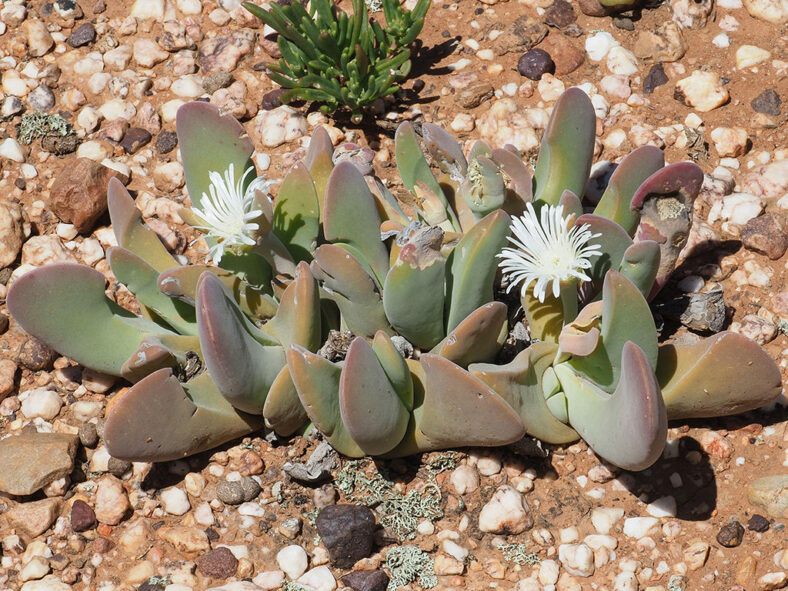Gibbaeum schwantesii is not accepted as a separate species and is treated as a synonym of the very variable Gibbaeum velutinum.
Scientific Name
Gibbaeum schwantesii Tischer
Accepted Scientific Name
Gibbaeum velutinum (L.Bolus) Schwantes
Scientific Classification
Family: Aizoaceae
Subfamily: Ruschioideae
Tribe: Ruschieae
Genus: Gibbaeum
Etymology
The specific epithet "schwantesii" (pronounced "shwan-TEZ-ee-eye") honors Gustav Schwantes (1881-1960), a German archaeologist and botanist specialist of the Aizoaceae family.
Origin
Gibbaeum schwantesii is native to South Africa. It grows on quartz gravel outcrops among succulent shrubs in Springfontein, Western Cape.
Description
Gibbaeum schwantesii is a dwarf succulent with very short, woody stems and fleshy, very unequal leaves. It resembles the typical form of Gibbaeum velutinum but lacks a rootstock; its leaves grow directly from the soil. Additionally, it has larger flowers. The leaves are narrowly triangular with hooked tips and can grow up to 4 inches (10 cm) long, typically measuring 2 to 5 times longer than they are wide.
The solitary flowers appear from late winter to spring and are usually white or cream, occasionally displaying a pale pink or violet hue. They can reach a diameter of 2 inches (5 cm) and emerge on pedicels at the angle between old and new leaves. The pedicels can grow up to 2 inches (5 cm) long. The fruits are 6-locular capsules.

How to Grow and Care for Gibbaeum schwantesii
Light: Gibbaeum schwantesii requires bright light but not too much direct sunlight. So, a windowsill that receives 4 to 5 hours of direct sunlight in the morning and partial shade in the afternoon will be a perfect spot for indoor growing.
Soil: The plant thrives in porous soil, allowing the water to drain away quickly. Therefore, use commercial soil for succulents or make your own well-draining mix.
Temperature: High temperatures are not a problem as long as there is plenty of fresh air, but this plant is not cold-hardy. It grows best in USDA Plant Hardiness Zones 9b to 11b, with average minimum winter temperatures ranging from 25°F to 50°F (-3.9°C to 10°C).
Watering: To keep your Gibbaeum schwantesii healthy, it is most important to know when, how much, and how often to water it. During the dormant period, usually in winter, the plant requires little or no water. From spring to fall, water it thoroughly but allow the soil to dry between waterings.
Fertilizing: As long as you repot this plant every two years, it does not need fertilizer.
Repotting: Even if the plant can stay happy in the same pot for years, you can repot it once in a while to give it more space anytime during the growing season. However, the best time is at the beginning of the growing season.
Propagation: Dividing clumps is a simple way to propagate this plant. Another option is to start from seeds by sowing them in well-draining soil during spring. The best time to divide the plant is late spring or early summer.
Learn more at How to Grow and Care for Mesembs.
Toxicity of Gibbaeum schwantesii
Gibbaeum schwantesii is considered non-toxic and safe around kids and pets.
Links
- Back to genus Gibbaeum
- Succupedia: Browse succulents by Scientific Name, Common Name, Genus, Family, USDA Hardiness Zone, Origin, or cacti by Genus
Photo Gallery
Click on a photo to see a larger version.


